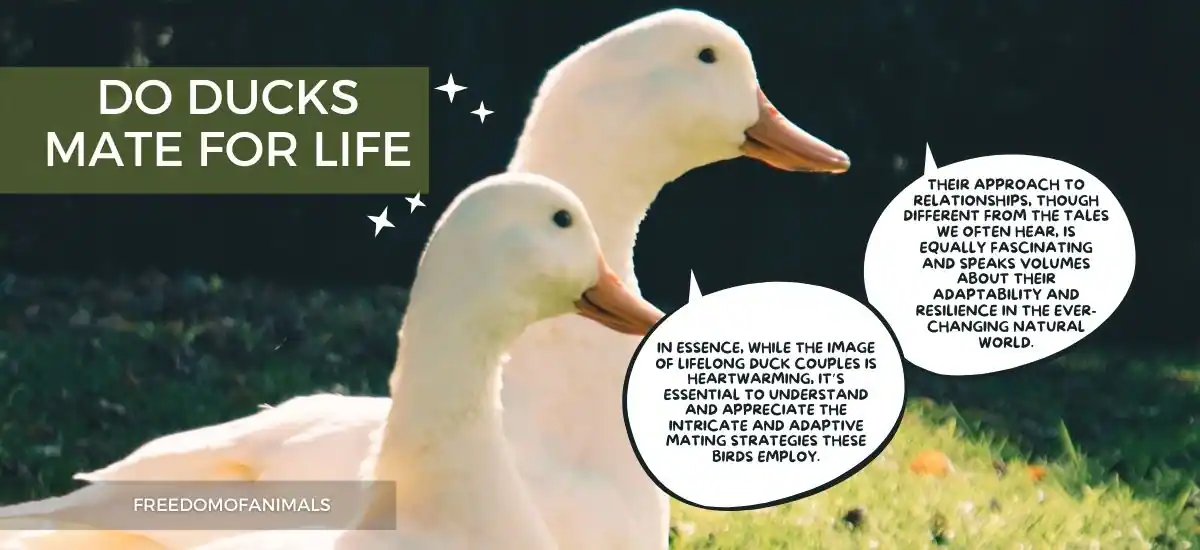Ducks, with their serene presence on ponds and iconic quacking, have long captured the human imagination. But beyond the placid surface lies a world of intricate relationships and mating dynamics that defy common myths.
While many envision a fairy-tale scenario where drakes and ducks form lifelong bonds, the reality is far more complex. In this comprehensive guide, we delve deep into the world of duck mating rituals, debunking widely-held beliefs and shedding light on the fascinating behaviors that define their reproductive lives.
From the nuances of seasonal monogamy to the elaborate courtship displays, we aim to provide a holistic understanding of these waterfowl’s romantic endeavors. Join us as we navigate the intricate dance of duck relationships, offering insights that promise to both educate and intrigue.
The Myth of Lifelong Mating
The world of avian relationships is as diverse as the birds themselves. Among the many misconceptions surrounding bird behavior, one stands out prominently: the belief that all waterfowl, including ducks, mate for life. This romanticized notion paints a picture of unwavering loyalty and lifelong commitment, akin to the tales of swans or geese. However, the reality of duck relationships is more nuanced.
Unlike their larger counterparts, geese and swans, who are often celebrated for their enduring pair bonds, ducks have a different approach to relationships. Most duck species practice what is termed ‘seasonal monogamy.’
This means that while they do form bonds and pair up, these relationships are typically short-lived, lasting just for the breeding season. Once the season concludes, both partners often go their separate ways, ready to find new mates the following year.
This behavior is not indicative of any lack of commitment on the ducks’ part. Instead, it’s a survival strategy, ensuring genetic diversity and optimizing the chances of successful offspring. By diversifying their mates, ducks can adapt to changing environments and challenges, ensuring the survival of their lineage.
In essence, while the image of lifelong duck couples is heartwarming, it’s essential to understand and appreciate the intricate and adaptive mating strategies these birds employ. Their approach to relationships, though different from the tales we often hear, is equally fascinating and speaks volumes about their adaptability and resilience in the ever-changing natural world.
Seasonal Monogamy in Ducks
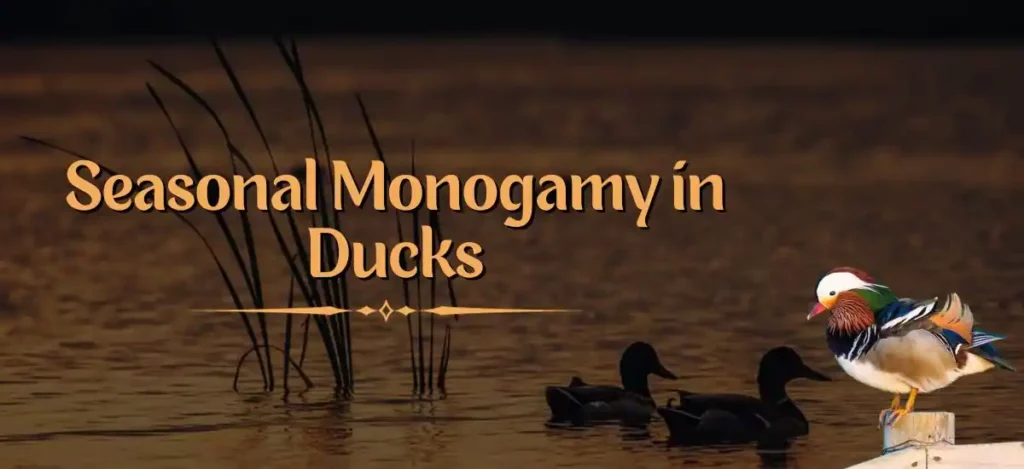
‘Seasonal monogamy’ is a common practice among ducks, where they form monogamous relationships that last primarily for the breeding season. This strategy allows ducks to introduce genetic diversity into their offspring, enhancing their resilience against potential threats.
During their partnership, duck pairs showcase deep bonds, engaging in synchronized behaviors to ensure the success of their future ducklings. However, once the breeding season ends and their responsibilities are fulfilled, both ducks often seek new mates for the next season.
This cyclical pattern of relationships is not a sign of fickleness but a strategic choice, ensuring the continuation and adaptability of their species in various ecosystems.
The Role of Males in Raising Ducklings
- Division of Labor: In the world of ducks, there’s a clear division of parenting responsibilities between males and females.
- Initial Involvement: Both male and female ducks are actively involved in the early stages of courtship and nest-building.
- Shift in Responsibilities: Once the eggs are laid, the primary duty of raising the ducklings falls on the female.
- Male’s Limited Role: After breeding, male ducks often distance themselves, with many leaving the breeding grounds entirely. Their focus shifts to molting or preparing for the subsequent breeding season.
- Female’s Solo Endeavor: The mother duck takes on the role of protector, guide, and teacher for the ducklings. She defends them from predators, ensures they’re fed, and teaches them survival skills.
- Evolutionary Strategy: The male’s absence post-breeding and the female’s solo parenting role are rooted in evolutionary strategies that ensure the survival and continuation of the species.
- Resilience of Female Ducks: Female ducks showcase adaptability and resilience as they single-handedly raise the next generation, highlighting the intricate balance in the duck world.
Exceptions to the Rule
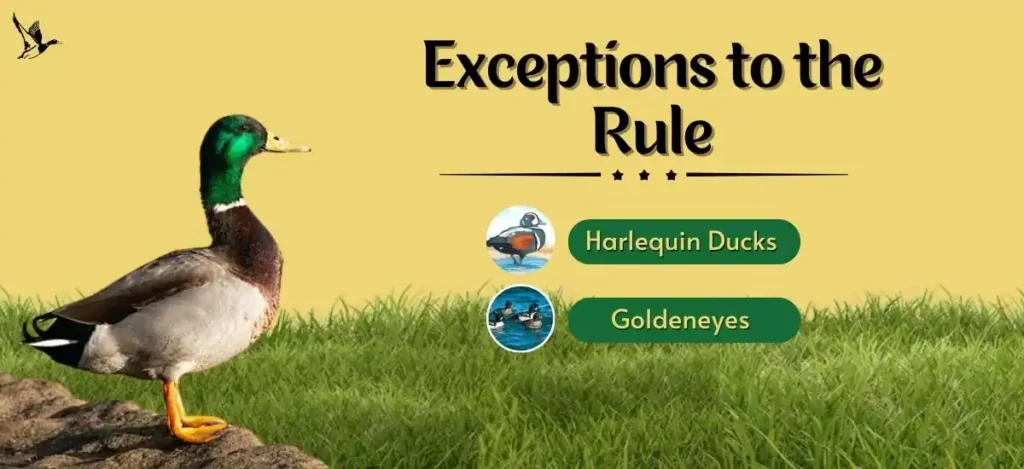
While the general trend in the duck world leans towards seasonal monogamy and the cyclical nature of relationships, nature is replete with exceptions, and ducks are no different.
Certain species deviate from the norm, showcasing patterns of re-pairing or even longer-term bonds. Notably, harlequin ducks and goldeneyes stand out in this regard. These species, unlike their counterparts, have been observed to form bonds that extend beyond a single breeding season.
- Harlequin Ducks: Known for their striking plumage and strong pair bonds, harlequin ducks often return to the same mate year after year. Their loyalty to a specific breeding site, combined with their tendency to re-pair, makes them unique in the duck world. This behavior is believed to be linked to the specific challenges and demands of their habitat, which benefit from the continuity of a familiar partner.
- Goldeneyes: Another exception to the general trend, goldeneyes, particularly the common goldeneye, have been observed to re-pair with previous mates. While not as consistent as harlequins, the phenomenon is significant enough to be noted by ornithologists.
It’s essential to understand that these exceptions don’t undermine the broader patterns observed in duck relationships but rather enrich our understanding of the diverse strategies ducks employ for reproduction and survival. Whether it’s the adaptability of seasonal monogamy or the stability of re-pairing, each strategy plays a crucial role in the survival and success of these fascinating waterfowl.
Duck Courtship Rituals
The world of ducks is not just about survival and adaptation; it’s also filled with elaborate displays of affection, intricate dances, and vocal performances. The courtship rituals of ducks are a mesmerizing spectacle, showcasing the lengths these birds go to in order to attract a mate.
- Head Bobbing: One of the most common displays, head bobbing involves both the male and female ducks rhythmically moving their heads up and down. This synchronized dance is often the starting point of many courtship displays.
- Grunt-Whistle and Coos: Male ducks, especially mallards, produce a unique grunt-whistle sound during courtship, often accompanied by soft coos. These vocalizations play a pivotal role in attracting potential mates.
- Tail Wagging: A subtle yet significant gesture, tail wagging by male ducks signals interest and is often directed towards a female they’re courting.
- Victory Lap: After successful copulation, the male duck often performs a ‘victory lap,’ swimming around the female in a display of triumph and to ward off other potential suitors.
- Feather Fluffing: By fluffing their feathers, ducks make themselves appear larger and more impressive, showcasing their vitality and health to potential mates.
- Bill Nudging: A more intimate gesture, bill nudging involves the male gently nudging the female’s neck or back, signaling a deeper level of interest and affection.
- Water Uptake Display: Some male ducks engage in a display where they scoop up water in their bills and let it fall out in a rhythmic manner, often accompanied by specific vocalizations.
- Mirrored Movements: In some species, the male and female engage in mirrored movements, where they mimic each other’s actions in a synchronized manner, further strengthening their bond.
In essence, the courtship rituals of ducks are a blend of visual, vocal, and tactile displays, each designed to impress and woo a potential mate. These rituals not only highlight the beauty and complexity of duck behavior but also underscore the importance of communication and connection in the natural world.
Related Post: If My Dog Has A Runny Nose What Can I Give Him?
Choosing a Mate: The Female’s Perspective
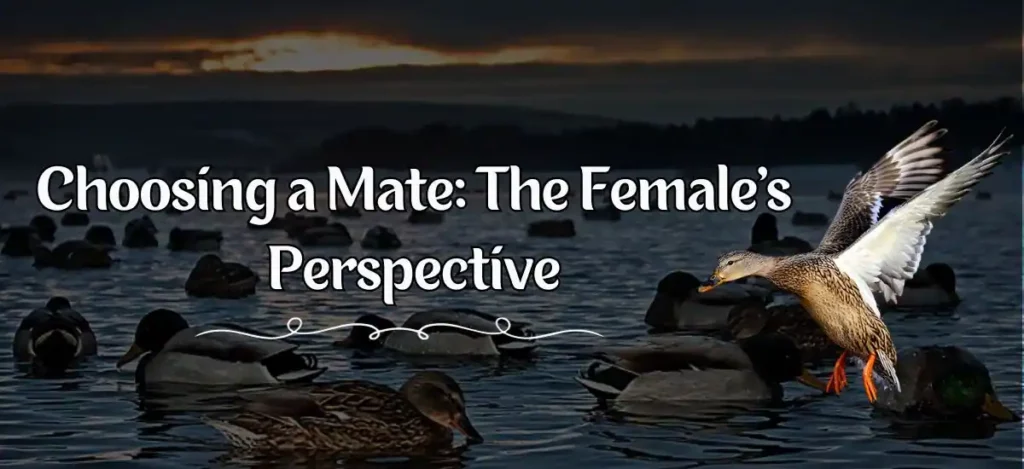
In the intricate ballet of duck courtship, while males put on elaborate displays, it’s the females who hold the decisive power. Their choices can significantly influence the genetic future of the species. But what factors influence a female duck’s decision when selecting a mate?
- Plumage Brilliance: A male duck’s plumage is not just for show. The vibrancy and health of his feathers can be a direct indicator of his overall health, genetic fitness, and potential as a suitable partner. Females often gravitate towards males with the brightest and most striking plumage, viewing it as a sign of a strong genetic makeup.
- Vocal Calls: Just as humans are drawn to a captivating voice, female ducks pay keen attention to the calls of potential mates. A loud, clear, and distinct call can indicate a male’s vitality and strength. Those with the most resonant and unique calls often stand out in the female’s assessment.
- Display Mastery: The finesse with which a male duck performs his courtship rituals can significantly influence a female’s decision. Mastery in displays, from head bobbing to the victory lap, indicates experience, maturity, and fitness.
- Territorial Dominance: A male’s ability to secure and defend a prime territory, especially one rich in resources, can be a significant factor. It not only showcases his strength but also his potential to provide a safe nesting site.
- Previous Partnerships: In species where re-pairing is common, a female might choose a previous mate based on the success of their past breeding season. Familiarity and proven success can play a role in her decision.
- Aggressiveness vs. Gentleness: While aggressive males might ward off competitors, females might also consider the gentleness of a suitor, especially if he displays less aggressive behaviors during courtship.
- Health and Vigor: Beyond displays and calls, the overall health, vitality, and activity levels of a male can influence a female’s choice. A robust and active male is often seen as a preferred mate.
In conclusion, the process of mate selection from a female duck’s perspective is a complex interplay of various factors. It’s a blend of instinct, observation, and experience, ensuring that her offspring have the best possible start in life. The dance of courtship and mate selection underscores the depth of strategy and instinct that goes into the continuation of the species.
The Reality of Forced Copulation
The world of duck courtship, while often filled with synchronized dances and harmonious calls, also has its shadows. One of the more somber aspects of duck mating is the phenomenon of forced copulation. This behavior, starkly contrasting the consensual courtship rituals, brings to light the challenges and dangers female ducks often face.
- Nature of the Act: Forced copulation, as the name suggests, involves male ducks attempting to mate with females without their consent. It’s an aggressive act, often involving multiple males targeting a single female.
- Reasons Behind the Behavior: Several factors contribute to this behavior. High male-to-female ratios, competition for mates, and the drive to spread genetic material can lead some males to resort to such aggressive tactics.
- Dangers to Female Ducks: The act is not without its risks for female ducks. As highlighted, drowning during such forced mating attempts is a significant threat. With multiple males often involved, females can be submerged underwater, leading to fatal outcomes.
- Evolutionary Countermeasures: Over time, female ducks have evolved certain anatomical features to counter forced copulations. Complex reproductive tracts, with twists and turns, allow females some control over which sperm fertilizes their eggs.
- Impact on Duck Communities: Forced copulation can disrupt the harmony of duck communities. It can lead to increased stress, lower successful mating rates, and even physical harm to females.
- Conservation Implications: In areas with declining duck populations, forced copulation can further exacerbate the problem. With fewer females available, aggressive mating behaviors can increase, leading to lower reproductive success and further population decline.
- Addressing the Issue: Conservationists and researchers are studying ways to mitigate the impact of forced copulation. Strategies include habitat management to ensure balanced male-to-female ratios and creating safe breeding environments.
In wrapping up, it’s crucial to understand that while forced copulation is a grim aspect of duck behavior, it’s part of the complex web of evolutionary strategies and survival tactics. Recognizing and addressing this behavior is essential not only for the well-being of individual ducks but also for the overall health and continuity of duck populations.
Know About: How To Get Rid Of Dog Hiccups: Symptoms Prevention, & Cures
Duck Mating Across Different Species
| Duck Species | Mating Behavior and Rituals |
| Mallards | Often associated with forced copulation. Males showcase vibrant plumage and distinctive calls during courtship. |
| Wood Ducks | Form strong pair bonds. Males use vocalizations and wing displays; mutual preening is common. |
| Northern Pintails | Males perform a “nod-swim” display, emphasizing their long necks while swimming towards females. |
| Teals | Blue-winged and green-winged teals use high-pitched whistles and display colorful wing patches. |
| Redheads | Males throw their heads back and emit a cat-like call to attract females. |
| Canvasbacks | Engage in a “rush display,” where males run over the water’s surface to showcase agility. |
| Buffleheads | Males perform jumps, splashes, and unique vocalizations as part of their courtship. |
| Eiders | Known for communal nesting. Males use visual displays and deep calls. |
| Ruddy Ducks | Males beat their bills against their chests, creating bubbles to impress females. |
| Shovelers | Engage in “head pumping” where both the male and female rhythmically move their heads up and down. |
This table provides a concise overview of the mating behaviors and rituals of different duck species.
The Aftermath: What Happens When a Duck Mate Dies?
The bonds formed between duck pairs, whether seasonal or long-term, are profound. So, what transpires when one-half of this bond is suddenly severed due to the death of a mate?
- Grieving Process: Just as with many animals, ducks too seem to exhibit signs of grief. They might be seen lingering around the place where they last saw their mate or calling out repeatedly in a seemingly distressed manner.
- Disorientation and Confusion: The sudden absence of a mate can lead to visible confusion. The surviving duck might appear lost, spending extended periods floating aimlessly or neglecting usual activities like foraging.
- Search for a New Mate: Depending on the time of year and the species, the surviving duck might embark on a quest to find a new mate. This is more common if the loss occurs just before or during the breeding season.
- Impact on Offspring: If the pair had offspring, the death of one parent, especially the mother, can have detrimental effects on the ducklings’ survival chances, given the pivotal role she plays in their upbringing.
- Solitude: Some ducks might choose to remain solitary for a while, avoiding the company of other ducks and preferring isolated spots.
Same-Sex Pairings in Ducks
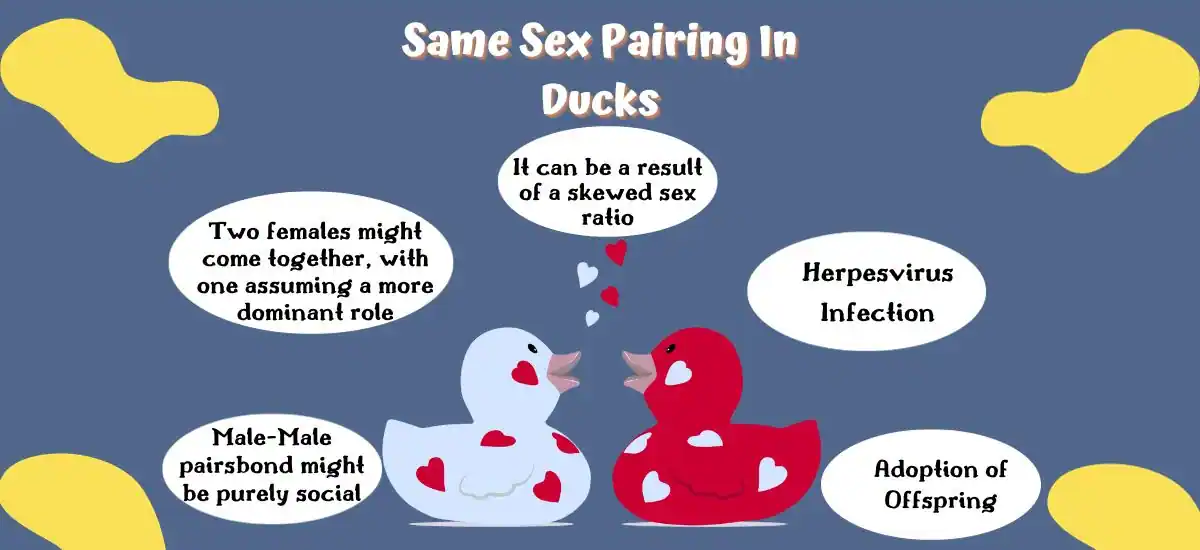
Nature is diverse, and ducks are no exception. Beyond the typical male-female pairings, there have been observations of same-sex relationships among ducks.
- Reasons for Same-Sex Pairings: While the exact reasons remain a subject of study, some theories suggest that same-sex pairings can be a result of a skewed sex ratio, strong social bonds, or even mutual benefits like protection from predators.
- Female-Female Pairs: Such pairings are often observed in species where there’s a shortage of males. Two females might come together, with one assuming a more dominant role. Interestingly, they might even lay eggs in a shared nest, taking turns incubating.
- Male-Male Pairs: These pairings can be particularly strong in species known for elaborate courtship displays. The bond might be purely social, or in some cases, they might engage in mimicry of typical mating behaviors.
- Adoption of Offspring: There have been instances where same-sex duck pairs have adopted abandoned eggs or ducklings, raising them as their own.
- Social Implications: Same-sex pairings, especially in environments with limited resources, can influence the broader dynamics of the duck community, affecting mating patterns and territorial disputes.
In conclusion, the world of duck relationships is multifaceted, from dealing with the loss of a mate to the diverse nature of pairings. These behaviors underscore the adaptability and complexity of ducks, revealing patterns that resonate with broader themes of love, loss, and survival in the animal kingdom.
Frequently Asked Questions
Q1. Why Do Ducks Wag Their Tails?
Ans: Tail wagging in ducks can signify various emotions and intentions. It can be a sign of contentment, a response after preening, or even an indicator of interest during courtship rituals.
Q2. What Do Ducks Eat?
Ans: Ducks have a varied diet that includes aquatic plants, small fish, insects, and even crustaceans. The specific diet often depends on the species and the availability of food in their habitat.
Q3. Why Do Ducks Have Webbed Feet?
Ans: Webbed feet act as paddles, allowing ducks to swim efficiently. This adaptation is crucial for their aquatic lifestyle, helping them navigate water bodies with ease.
Q4. Are There Same-Sex Pairings In Ducks?
Ans: Yes, same-sex pairings have been observed in certain duck species. These pairings can be a result of various factors, including social bonds, skewed sex ratios, or mutual benefits.
Conclusion
Ducks exhibit a rich tapestry of mating behaviors, challenging the simplistic view of lifelong partnerships. Their courtship rituals, responses to mate loss, and even same-sex pairings highlight their adaptability and the intricate dynamics of their social world.
Beyond mating, their varied diet, migratory habits, and unique physiological traits further showcase their complexity. In essence, ducks represent the delicate balance and multifaceted nature of the animal kingdom.
Read More:
